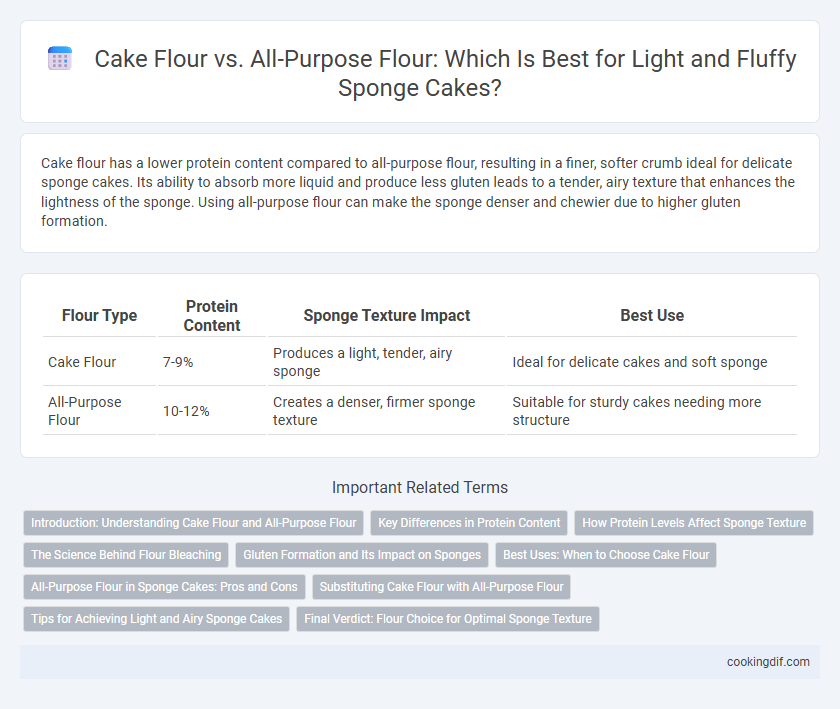Cake flour has a lower protein content compared to all-purpose flour, resulting in a finer, softer crumb ideal for delicate sponge cakes. Its ability to absorb more liquid and produce less gluten leads to a tender, airy texture that enhances the lightness of the sponge. Using all-purpose flour can make the sponge denser and chewier due to higher gluten formation.
Table of Comparison
| Flour Type | Protein Content | Sponge Texture Impact | Best Use |
|---|---|---|---|
| Cake Flour | 7-9% | Produces a light, tender, airy sponge | Ideal for delicate cakes and soft sponge |
| All-Purpose Flour | 10-12% | Creates a denser, firmer sponge texture | Suitable for sturdy cakes needing more structure |
Introduction: Understanding Cake Flour and All-Purpose Flour
Cake flour contains lower protein content, typically around 7-8%, which results in finer, softer crumb ideal for delicate sponge cakes. All-purpose flour has a higher protein level, approximately 10-12%, providing more gluten formation and a denser texture not suited for light, airy sponges. This fundamental difference in protein content and texture influences the choice between cake flour and all-purpose flour in sponge cake recipes.
Key Differences in Protein Content
Cake flour contains approximately 7-9% protein, significantly lower than all-purpose flour's 10-12%, resulting in a finer, softer crumb ideal for delicate sponge cakes. The reduced protein content in cake flour limits gluten formation, which helps create a tender and airy texture. In contrast, all-purpose flour produces a denser, chewier sponge due to its higher gluten development potential.
How Protein Levels Affect Sponge Texture
Cake flour contains lower protein levels, typically around 7-9%, which results in a finer, softer sponge texture by producing less gluten formation during mixing. All-purpose flour, with higher protein content of 10-12%, develops more gluten, leading to a denser, chewier sponge. Understanding protein levels helps bakers achieve the desired lightness and tenderness characteristic of a classic sponge cake.
The Science Behind Flour Bleaching
Bleached cake flour contains additional chemical agents like chlorine gas that alter protein structure and starch gelatinization, resulting in finer, softer crumb ideal for delicate sponge cakes. The bleaching process not only whitens the flour but also weakens gluten formation, preventing toughness and promoting a tender, airy texture. In contrast, all-purpose flour, with higher protein content and no bleaching agents, produces denser sponges due to stronger gluten development and less starch modification.
Gluten Formation and Its Impact on Sponges
Cake flour contains lower protein and gluten content than all-purpose flour, resulting in less gluten formation and a finer, softer crumb in sponge cakes. The reduced gluten development prevents toughness, allowing sponges to remain tender and airy with a delicate texture. In contrast, all-purpose flour forms more gluten, which can produce a denser, chewier sponge unsuitable for ultra-light cakes.
Best Uses: When to Choose Cake Flour
Cake flour contains lower protein content, typically around 7-8%, which results in a lighter, finer crumb and spongier texture ideal for delicate cakes and pastries. It is best used when baking sponge cakes, chiffon cakes, and other soft desserts that require tender crumb structure without toughness. For recipes demanding a soft, airy texture, cake flour ensures optimal rise and fluffiness due to its reduced gluten formation compared to all-purpose flour.
All-Purpose Flour in Sponge Cakes: Pros and Cons
All-purpose flour, with its moderate protein content of 10-12%, provides a balance between tenderness and structure in sponge cakes, resulting in a slightly denser crumb compared to cake flour. It offers versatility and is widely available, making it a convenient choice, but may require careful mixing to avoid a tougher texture. Using all-purpose flour can yield flavorful sponge cakes with more chew, though it may sacrifice some of the delicate lightness achieved with the lower-protein cake flour.
Substituting Cake Flour with All-Purpose Flour
Cake flour has a lower protein content (around 7-8%) compared to all-purpose flour (10-12%), which results in a lighter, softer sponge texture ideal for delicate cakes. When substituting all-purpose flour for cake flour, removing 2 tablespoons of all-purpose flour per cup and replacing it with 2 tablespoons of cornstarch mimics the lower protein content to achieve similar tenderness. This adjustment helps maintain the desired airy crumb and fine structure typical of sponge cakes made with cake flour.
Tips for Achieving Light and Airy Sponge Cakes
Use cake flour, which contains lower protein content (6-8%) than all-purpose flour (10-12%), to achieve a tender and airy sponge texture. Sift the flour multiple times to incorporate air, enhancing the cake's lightness. Avoid overmixing the batter to maintain delicate gluten structures, ensuring a soft and spongy crumb.
Final Verdict: Flour Choice for Optimal Sponge Texture
Cake flour, with its lower protein content (7-8%), produces a tender, airy sponge texture by minimizing gluten development, making it the optimal flour choice for delicate cakes. All-purpose flour, containing higher protein levels (10-12%), creates a denser, sturdier crumb suitable for more robust baked goods but less ideal for light sponges. For achieving the quintessential soft and fluffy sponge, cake flour remains superior due to its fine grind and low gluten potential.
Cake flour vs All-purpose flour for sponge texture Infographic

 cookingdif.com
cookingdif.com